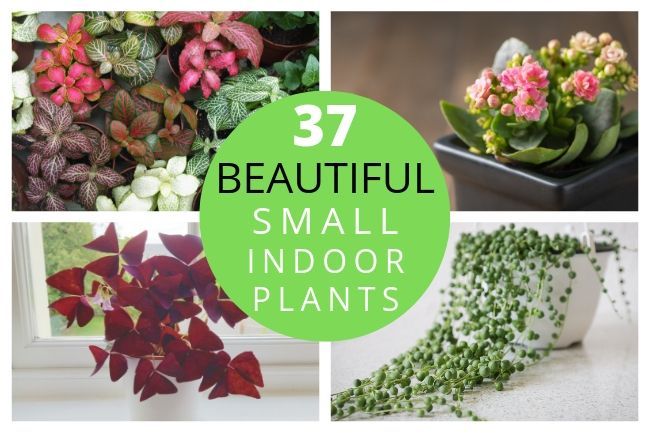Small houseplants are a great idea for so many reasons. They can be positioned almost anywhere, will brighten even the tiniest corner, and their small size means you can have the opportunity to grow a larger range of plants in a small space. This article is going to discuss some of my favorite small indoor plants that I know you will love.
1. Painted-Leaf Begonia (Begonia Rex)
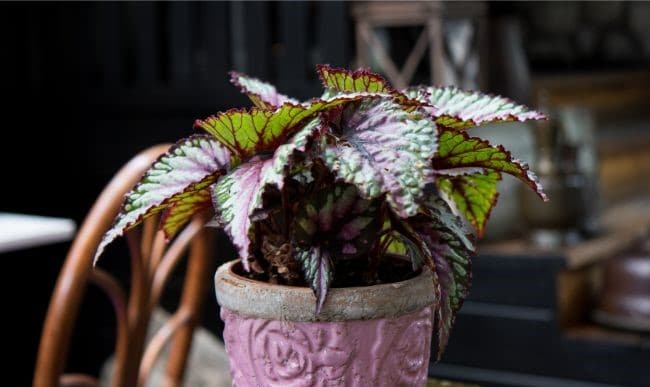
With flamboyant foliage and compact growth, Rex Begonias are an ideal small houseplant, and one that will always stand out when displayed in your home. It can be a little fussy about water, light and humidity, but it is a wonderful plant to grow.
Also known as the Painted-Leaf Begonia, this plant is all about it’s magnificent foliage rather than flowers. Discovered almost by accident in the 1850s, it is now one of the most popular small indoor plants. I’ve written an article all about how to get the best out of Rex Begonias grown indoors.
2. Nerve Plant (Fittonia)
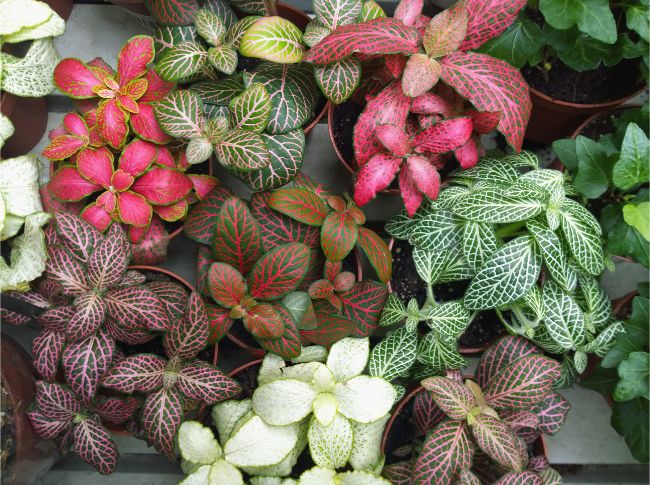
Nerve plants look amazing. Not the easiest plant to care for, but definitely a really rewarding one. They have high water and humidity requirements, but with a bit of attention, can be grown in most places. They are one of my favorite choices for growing in a terrarium.
The intricate lace-like vein pattern on their leaves is the star of the show here and I never get bored of looking at them. Keep the soil moist but not soggy and give them indirect sunlight and you’ll be well on the way to providing a happy environment for this cute indoor plant. The red-veined Fittonia verschaffeltii is probably my favorite, although they all look so good.
Read everything you need to know about Nerve Plants here, including how to care for them, and why they are worth the extra effort.
3. Moth Orchid (Phalaenopsis)
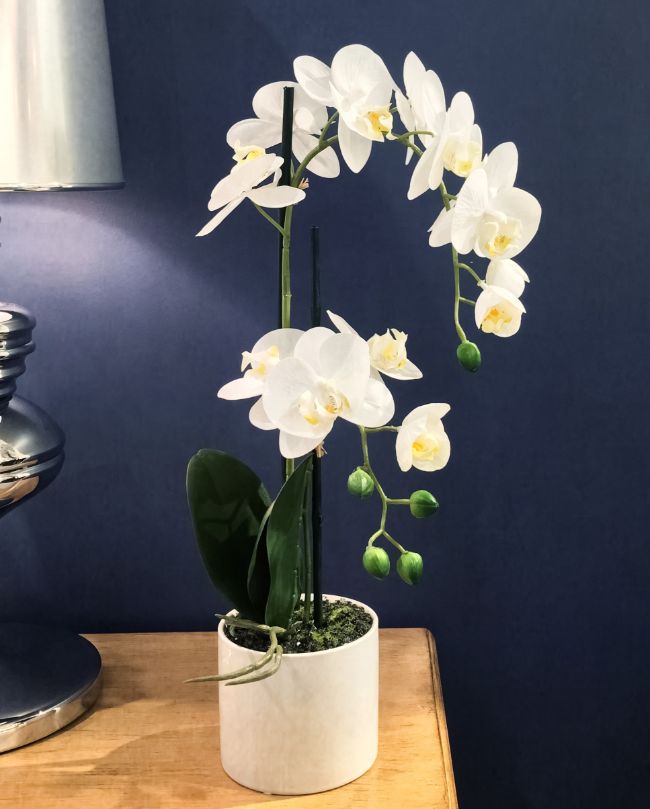
Lets just take a minute to appreciate the stunning beauty of phalaenopsis orchids. I would highly recommend Moth Orchids to anyone looking for a beautiful, yet small indoor plant.
The blooms last for months, and they’re much easier to care for than their appearance would suggest. Avoid direct sunlight and be careful not to overwater. A little dilute fertilizer every few weeks will help you get the best from your plant.
Phalaenopsis Orchids are taking over my house as I can’t help myself from buying more. These are my all-time favorite indoor plants and I’ve written about them extensively on this website.
4. Peperomia
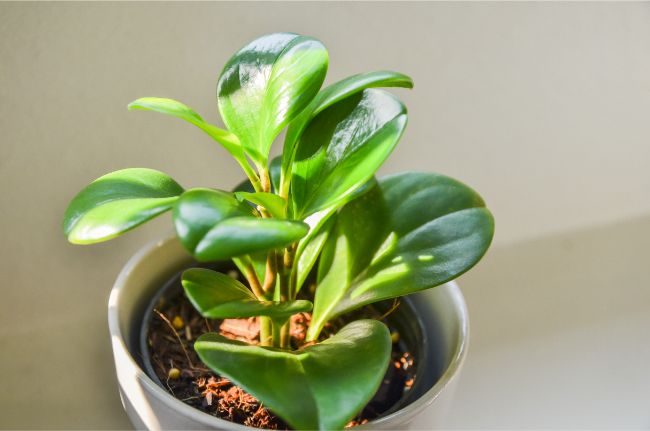
There is such a wide variety of Peperomia species that you could collect dozens of Peperomia plants and still not have two that look alike. These small indoor plants, many of which have succulent characteristics are easy to care for and look great. They are widely available and generally inexpensive.
Most species will do really well on an east or west facing windowsill and should be watered once the top inch of soil has dried out. Peperomia caperata and Peperomia graveolens are two of my personal favorites, but there is such variety, you are sure to find one you love. Read more about caring for Peperomia plants in this helpful article that I wrote.
5. Flamingo Flower (Anthurium)
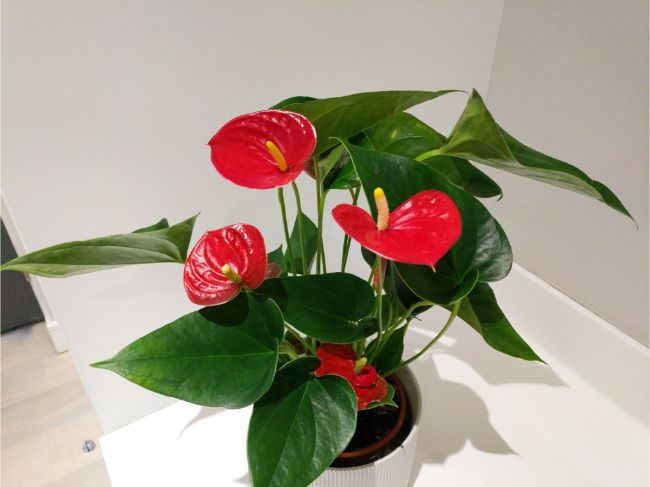
With showstopping colored blooms that can last year-round, this is a great option if you are looking for a fairly small indoor plant that will fit easily on a side table, shelf or windowsill. It grows to about 12-18 inches in height and has low care requirements. Plenty of bright indirect light will ensure that your Flamingo Flower blooms profusely.
Ensure well-draining soil and water thoroughly but infrequently and this beautiful indoor plant will thrive. I’ve written more about this plant and how to look after it here.
6. Alocasia Polly
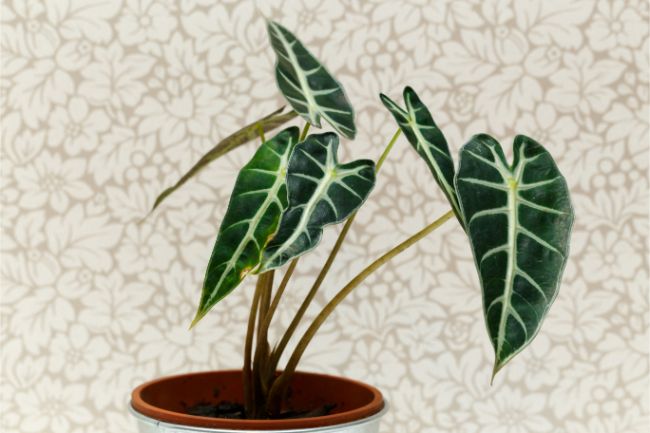
An Alocasia hybrid, Alocasia “Polly” is the common name for a smaller variant of the Alocasia Amazonica hybrid. There is much debate about the origin of this plant, but it sure does look great. It produces a small number of glossy, arrowhead-shaped leaves with prominent pale veins which contrast beautifully with the dark green foliage.
A little more tricky to care for, Alocasia Polly needs optimal conditions to remain healthy. Moderate to high humidity, constantly moist but not soggy potting mix and bright, but indirect sunlight are essential.
I would thoroughly recommend Alocasia Polly for those looking for more of a challenge. Alternatively, there are some other stunning, but more unusual Alocasia species that are well worth a look. Alocasia zebrina and Alocasia baginda ‘dragon scale’ are two massive favorites of mine.
7. Baby Toes (Fenestraria rhopalophylla)
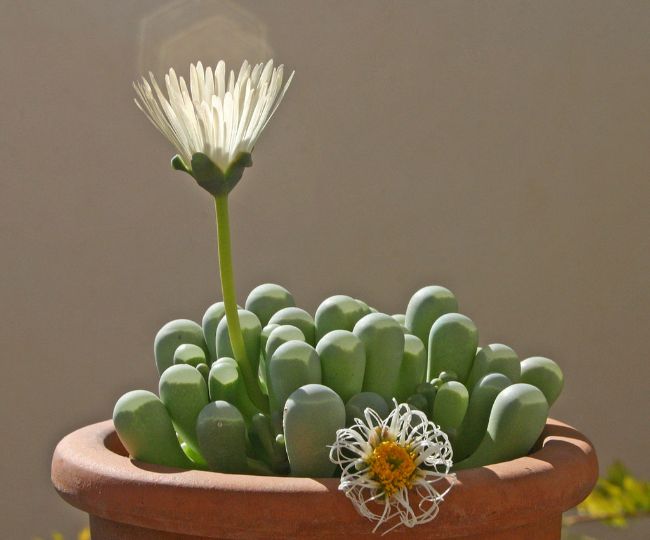
Such a cute little houseplant, it’s not hard to see why Baby Toes got its common name. This small indoor plant is suitable for the tiniest of spaces and perfect for display on its own or in an arrangement with other succulents.
Baby Toes will tolerate a range of light conditions, so will do well on a windowsill or in a darker corner. Being a succulent, well draining potting mix and infrequent watering are essential to keep this plant in good health.
I love popping a little Baby Toes plant into spaces on shelves, or into places that wouldn’t be suitable for larger or more demanding houseplants.
8. Aloe Vera
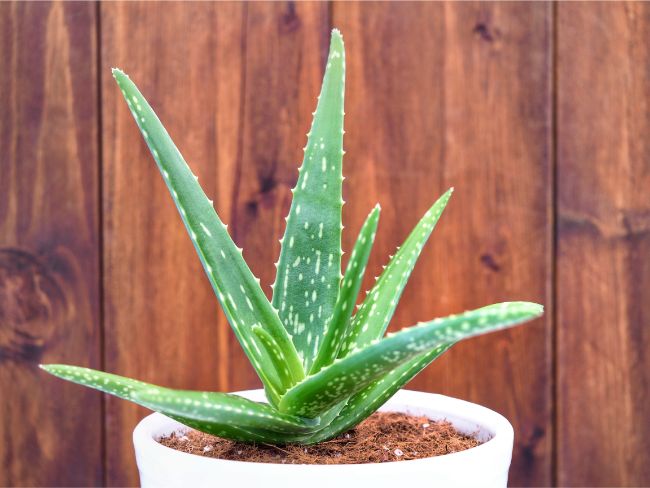
This attractive succulent is one of the most popular succulent houseplants. It’s long, thick, green leaves look great and it is really easy to care for.
Aloe Vera tolerates neglect and loves plenty of bright light, although will do well even in lower light conditions. Aloe Vera plants should be watered thoroughly once the potting mix is dry. Just be careful not to overwater Aloe Vera, as this can lead to root rot.
Aloe Vera Plants don’t just look nice either. Aloe Vera leaves contain a clear gel that is great for a range of skin problems such as sunburn.
9. Echeveria
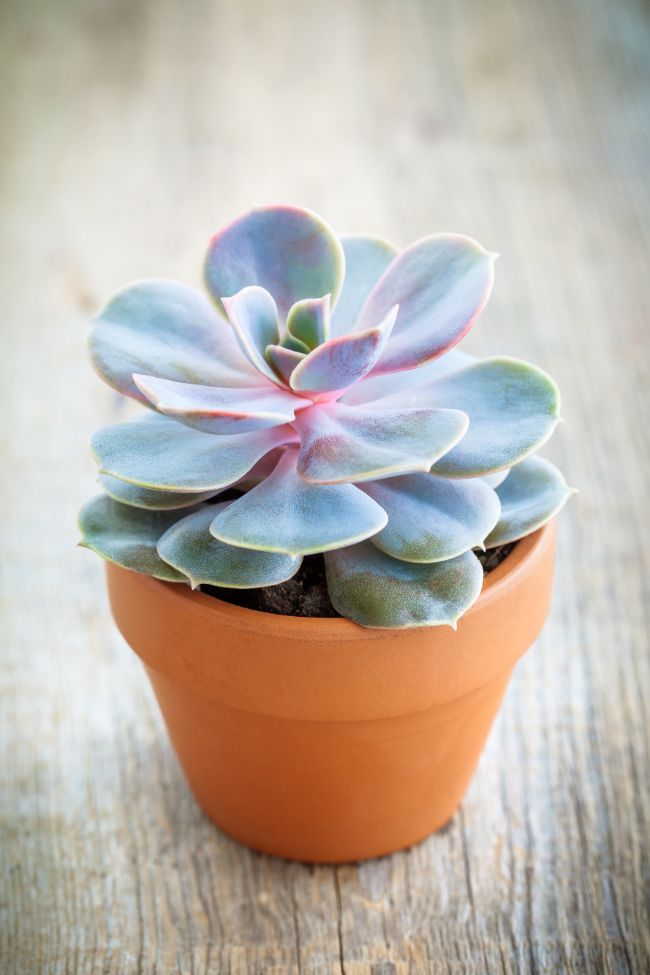
There is such a range of echeveria species, that you are bound to find one you adore. These compact succulents can be grown alone in tiny pots, or planted amongst other echeveria or other succulents to make really attractive arrangements.
Echeveria can be grown in a range of light conditions, but will stretch and become leggy over time if grown in lower light. This isn’t a major problem as they are easily propagated and your display can be refreshed easily if needed.
Due to their small size, echeveria can be placed almost anywhere in your home.
10. Chinese Money Plant (Pilea Peperomiodes)
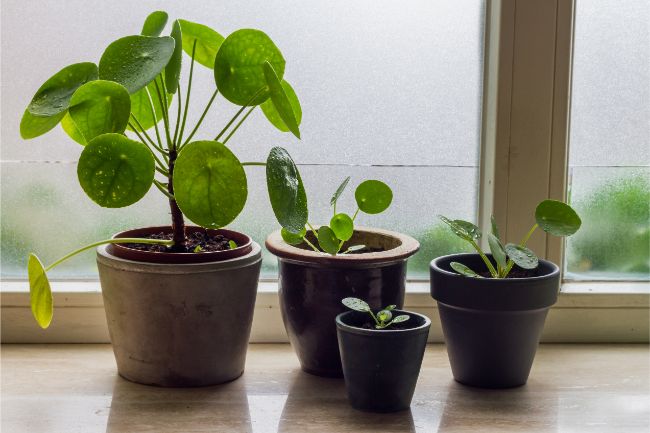
The Pass It On Plant or Chinese Money Plant as it is often known has exploded in popularity over the last few years. With glossy pancake-shaped leaves that most definitely have the wow factor, this is a plant in demand.
Easy to care for and with a tendancy to produce baby plant offsets that can be shared with your friends, this is a lovely small indoor plant to own.
11. Purple Shamrock (Oxalis triangularis)
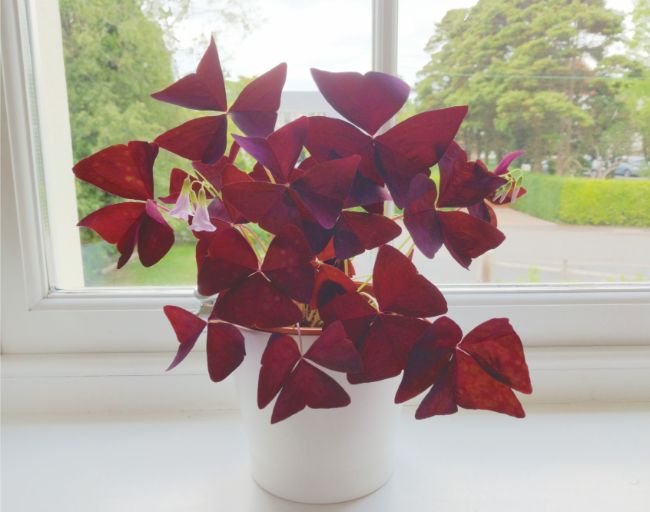
Planted from a bulb, this unfussy plant has amazing and unusual foliage which is really beautiful when on display. Deep purple trifolate leaves and delicate pale blue, white or purple flowers make this one of my favorite small indoor plants. The leaves close up at night and move to face the light during the day, providing an ever-changing look to your plant.
Also known as Purple Shamrock, or False Shamrock, they are very easy to grow, tolerating a range of light conditions and inconsistent watering. They are revived easily if they are neglected and can live for years. They will die back every autumn, and sprout again enthusiastically in the spring.
I’ve written an article that goes into more detail about how to care for Oxalis triangularis, including my own step by step experience of growing these from bulbs recently.
12. Air Plants (Tillandsia)
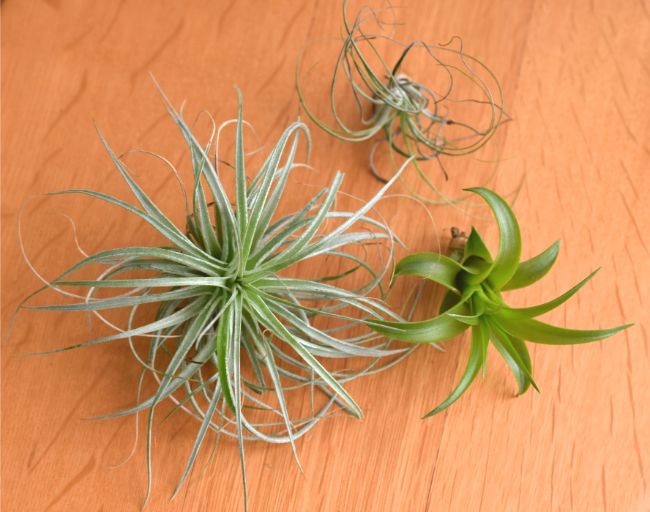
Air plants are easy to care for and a little bit different from most other small indoor plants. They don’t grow in soil, but live attached to branches or rocks.
Air plants can be displayed in a number of interesting ways in your home as you aren’t limited by having to pot them in soil. You can create beautiful displays, attaching them to rocks, shells, growing them in terrariums or even mounting your air plants on the wall.
They obtain most of the water they need directly from the air, but spraying or soaking them in water every week or two is usually required due to the relatively arid conditions of most homes.
13. Jade Plant (Crassula ovata)
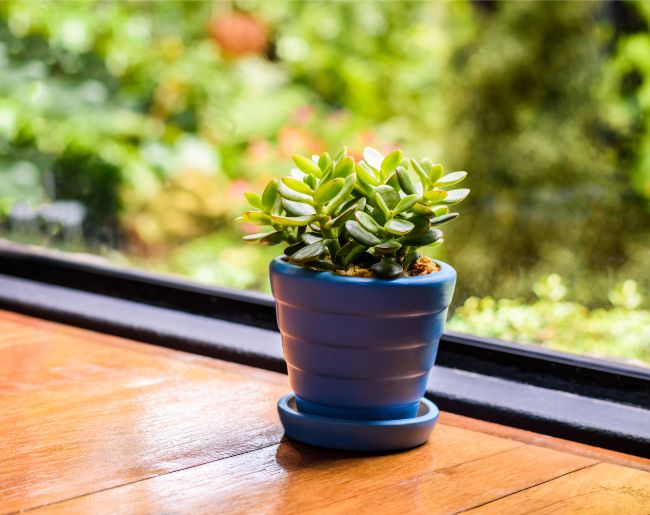
One of the most popular small houseplants and normally available just about everywhere you can buy indoor plants. Jade plants are ever popular due to their attractive looks and easy care requirements.
They are normally grown as small houseplants, but given sufficient space, time and care, they can grow to be quite large. Generally easy to care for, just watch out for overwatering and leaf drop. Read my complete jade plant care guide for everything you need to know about growing a wonderfully healthy jade plant.
14. Flaming Katy (Kalanchoe blossfeldiana)
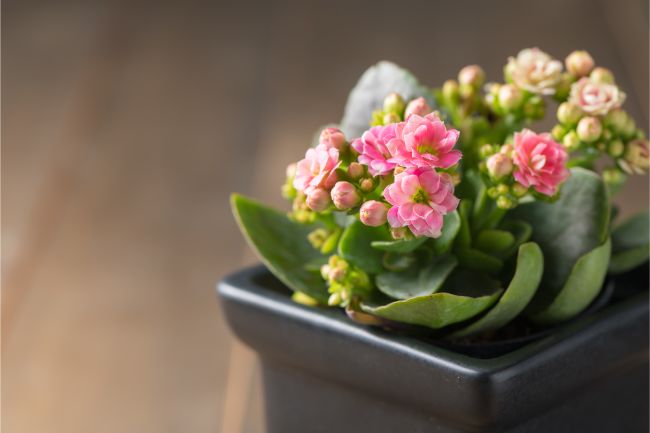
This winter blooming succulent is very popular and normally easy to find on sale through the winter and spring. It is a short day plant, which means that it begins blooming in response to the short days of late Autumn and early winter.
It can flower for many months if you prune spent blooms and provide plenty of light. As with other succulents, good drainage, and thorough, but infrequent watering is important. It comes in a range of colors including red, orange, yellow and white.
Most people treat Kalanchoe as an annual, disposing of it once it finishes blooming, but it is fairly easy to get it to rebloom if you provide the right conditions. Read my guide to caring for Kananchoe blossfeldiana to learn all you need to know to keep your plant in great shape and why this is a houseplant I recommend to almost everyone.
15. Living Stone Plant (Lithops)
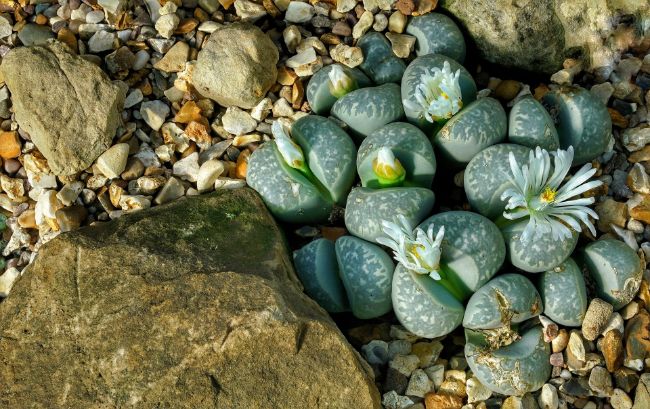
This small indoor plant is a bit unusual, but definitely one to add to your collection. Each lithops plant has just two leaves which look a little like an animal’s hoof.
Their nickname comes from the fact that they grow half buried in the ground in their natural habitat, blending in with other stones. need about I also think its because they need about as much care as a stone to be grown successfully.
Put this plant somewhere sunny, water no more than a few times per year, and enjoy. They come in a variety of colors, which can look very attractive and can be planted in little pots by themselves, or in groups.
Choosing a potting soil high in inorganic material is essential. The best strategy to ensure a healthy Lithops plant is to practically ignore it. Do not be tempted to water them more than the bare minimum, as overwatering is the one thing that can cause problems.
16. Polka Dot Plant (Hypoestes phyllostachya)
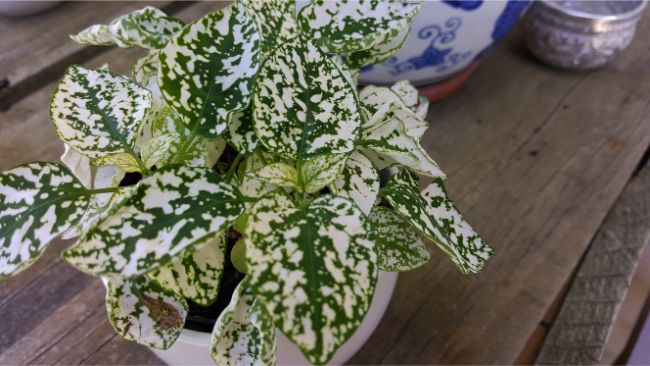
The Polka Dot Plant is another small houseplant which always catches the eye. Also known as the Freckle-face plant, it’s not too hard to see why.
The delicate, compact foliage comes with speckles of white, pink, red, yellow or green which make it a really interesting plant to look at. The foliage is quite different from most other houseplants, so provides great contrast in a group or display.
This is another plant that I love growing in a terrarium, due to its compact size and need for higher moisture and humidity needs. I’ve written an article all about how to grow this plant successfully, so if you want to know more, click here.
17. Pothos (Epipremnum aureum)
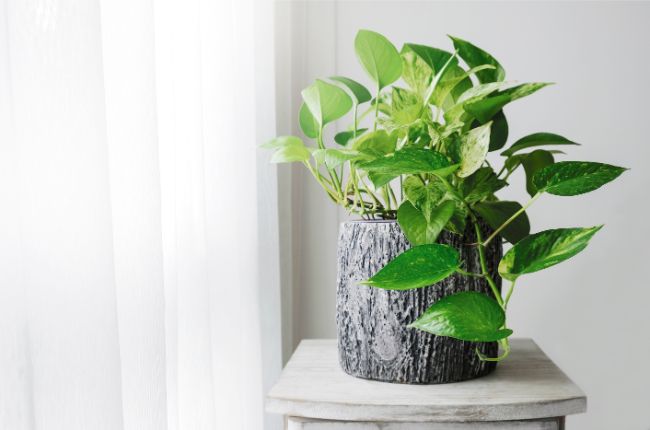
These climbing or trailing plants look great when their foliage dangles down from a shelf or windowsill, or even grown as a hanging plant in a Macrame hanging planter.
One of the easiest indoor plants to care for that I know, it is suitable for everyone. Although I’ve listed this as a small indoor plant, it is capable of growing to a decent size, but can be easily trimmed back to keep it to whatever size you prefer.
18. Snake Plant (Sansevieria trifasciata)
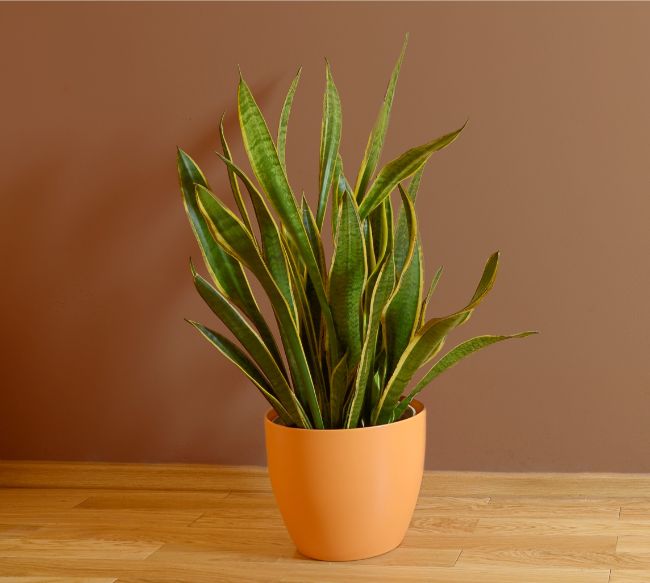
There’s been a big revival in the popularity of the Snake Plant over the last few years. This unfussy, modern looking plant requires minimal care and is fairly versatile in terms of displaying it at home.
Larger plants make great floor plants, but small varieties are suitable for just about anywhere. There are quite a varieties of Snake Plant species to choose from, and they can look amazing when a few different species are grouped together.
I water my Snake Plants about once per month or less and keep them in lower light locations in my home. They are really easy to care for, so wouldn’t hesitate to pick one up. The only word of warning is to avoid overwatering them, as this is the one sure-fire way to bring about their demise.
19. Spider Plant (Chlorophytum comosum)
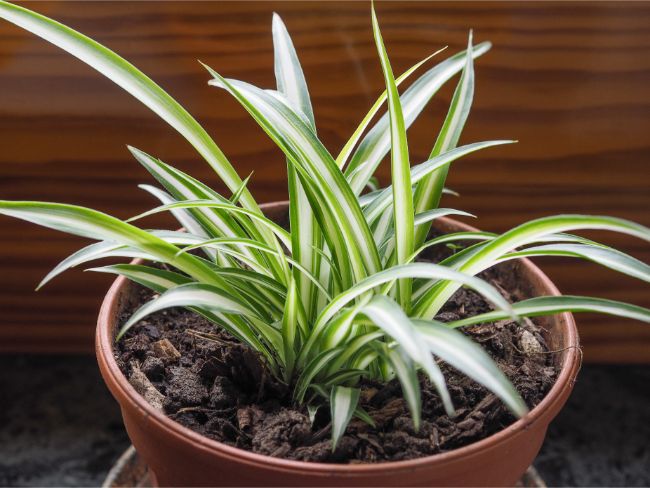
Ever popular spider plants are easy to care for and are a great option to grow regardless of the color of your gardening thumb. With ribbon-like variegated leaves and an enthusiastic desire to produce little offsets, they are interesting and rewarding to grow.
Brown tips can be a problem if neglected, but otherwise, there are few problems with this plant.
20. String Of Pearls Plant (Senecio Rowleyanus)
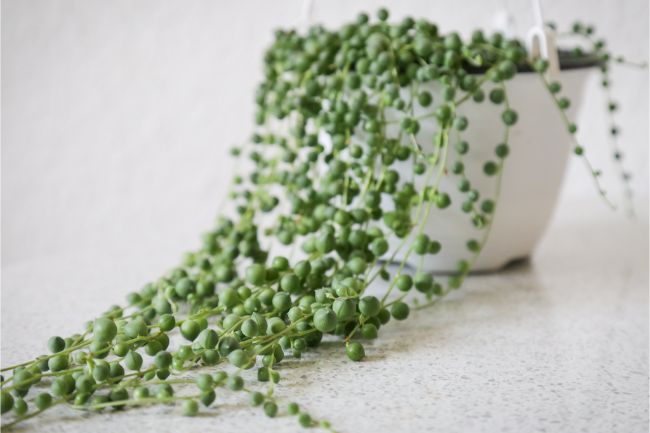
This unusual succulent is an ideal small houseplant due to its versatility. It has a tendency to want to cascade out of whatever container it is planted in, which can look great as it drapes down from a shelf, windowsill or from a hanging planter.
String Of Pearls Plant should be grown in well draining soil, watered infrequently and given plenty of light.
21. Cacti
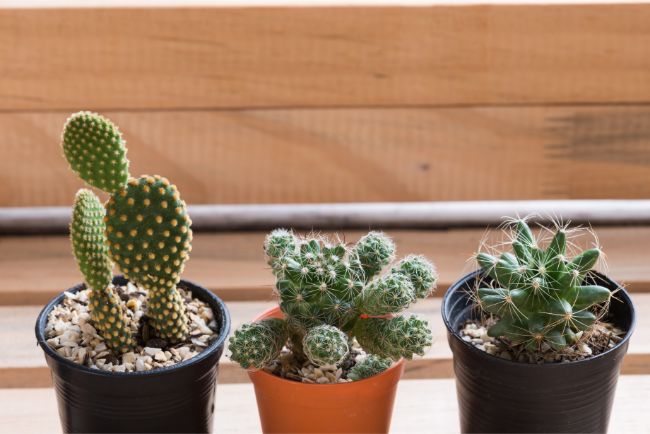
With so many different species to choose from, and many growing slowly and remaining quite small, cacti are ideal small indoor plants. Surprisingly, cacti will tolerate a range of lighting conditions, so it’s not necessary for them to be grown on a sunny windowsill. Cacti are adapted to survive periods of drought, so if you are prone to forgetting to water your plants, then cacti are for you. Just try not to overwater your cactus, as they really don’t like this.
22. Calathea
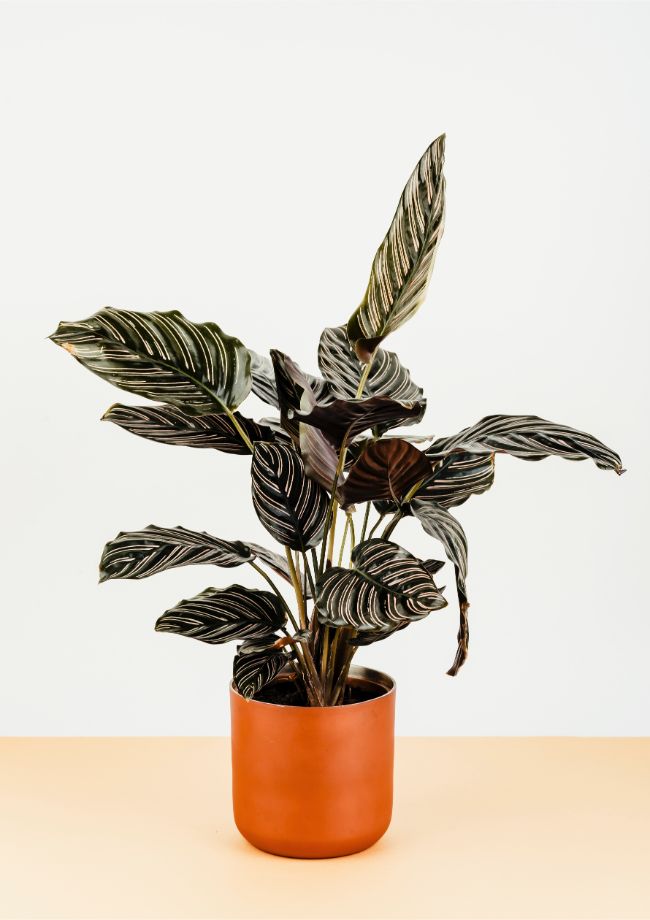
There are many Calathea houseplants to choose from and most of them have amazing foliage which will no doubt add some spectacle to your home. Species such as Calathea ornata, Calathea crocata, Calathea lancifolia and Calathea orbifolia are all stunningly beautiful houseplants.
Although a little larger than some of the plants on this list, most species will still fit comfortably on a side table or shelf. Calathea plants are generally more fussy about their care, requiring fairly precise watering, humidity and temperature control compared to other small houseplants.
I often suggest using filtered or distilled water for many Calatheas due to their fussy nature. Don’t be put off by the challenge of growing Clatheas. They are totally worth it and are some of the most rewarding indoor plants to grow. I’ve written more extensively about growing Calthea ornata and Calathea crocata, which you may find useful before buying one of these plants.
23. English Ivy (Hedera helix)
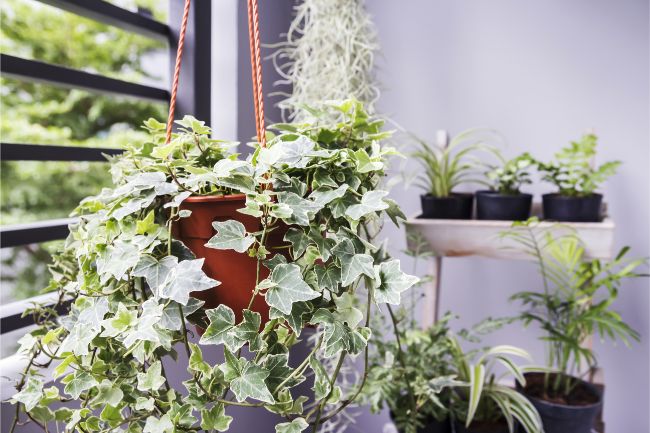
English Ivy has such versatility as an indoor plant. It looks great grown in a simple pot, where the vines will spill out the sides creating a wonderful display, but can also readily climb just about anything. If you give it an opportunity, it will readily climb a trellis, wall or even grow up shelves.
English Ivy comes in a variety of shades of green, as well as some quite striking variegated options. Young plants should be kept well watered, but once it is established, it can tolerate a lot of neglect.
24. Bromeliad
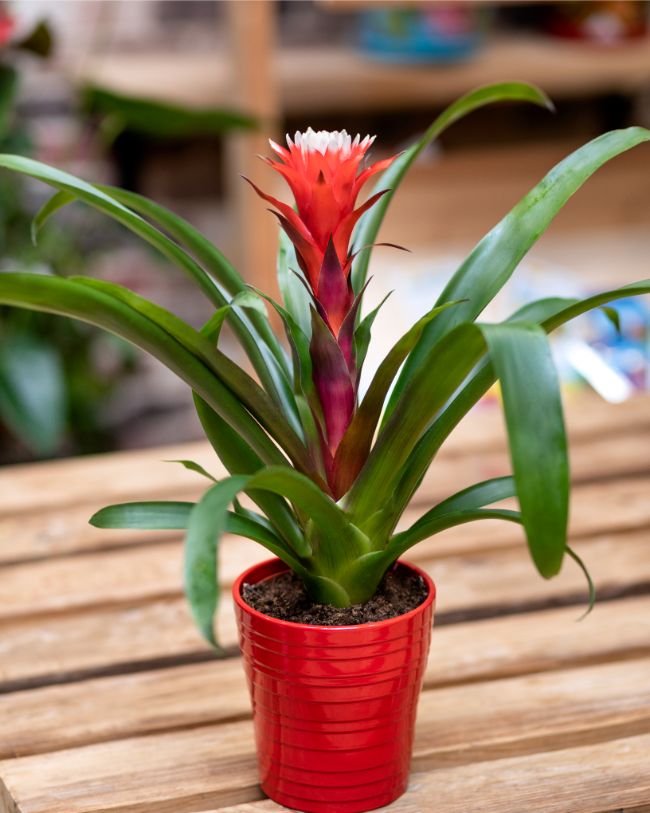
Bromeliads such as Guzmania, Aechmea Fasciata and Neoregelia make wonderful displays of color in an indoor space. An ideal table plant, they are generally easy to care for and their displays of color last for many months.
Most bromeliads are epiphytic plants, meaning that they use their roots to cling onto branches, rocks or other plants, rather than preferring to be planted in soil. They have a unique way of storing water via a cup formed from the foliage, which stores water to be used as needed.
Ensure your bromeliad is given bright light, but try to avoid direct sunlight. Put them near an east or west facing window, rather than right at a window.
25. Chinese Elm Bonsai
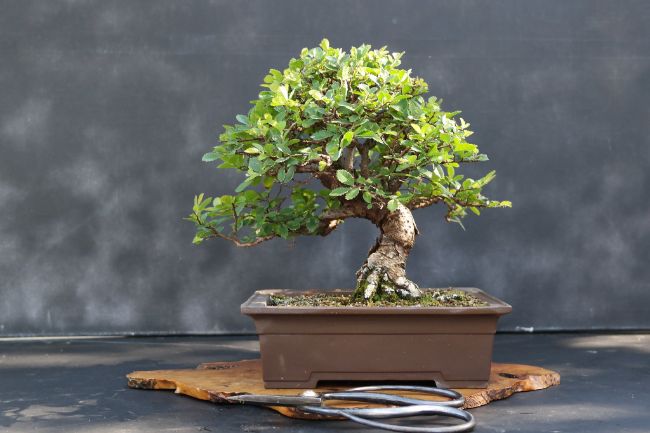
One of the most popular species of indoor bonsai tree, and one of the most forgiving. It grows strongly and will readily produce new branches and foliage from old wood.
Bonsai growing is an art and science in itself, and it can take a long time to master the care and pruning of a bonsai tree. However, for the novice grower, they are really interesting plants and a source of continual learning as you hone your skills.
Chinese Elm Bonsai should be planted in potting mix with a high proportion of inorganic material to ensure excellent drainage. Poorly draining or compacted soil will lead to your plant struggling to thrive.
Chinese Elm Bonsai like bright light and can tolerate a South facing window for most of the year. They can be semi-deciduous depending on light and temperatures during the colder months of the year. If your does lose a lot of leaves during the winter, don’t worry, as it will come again with renewed vigor in the spring.
26. Asparagus Fern (Asparagus aethiopicus)
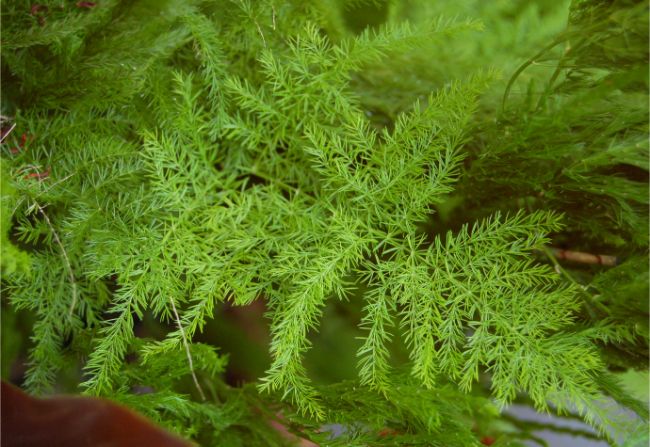
This delightful fern looks like something from a fairy garden, with it’s feathery foliage and cool green color.
High humidity will greatly help this plant remain healthy and you should keep it well pruned to maintain a bushy appearance.
27. Zebra Haworthia (Haworthiopsis fasciata)
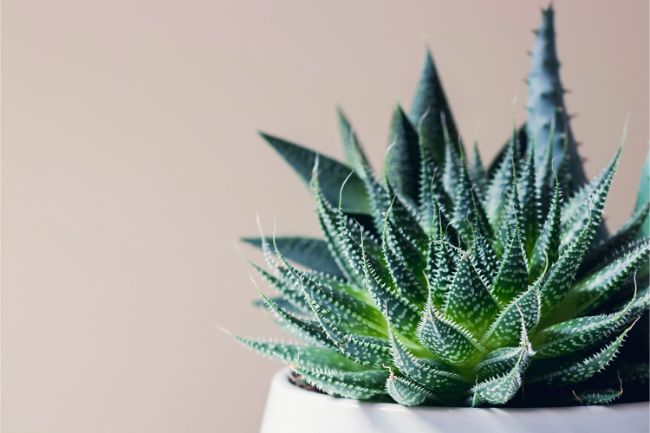
A real stand-out succulent, the striped appearance of the Zebra Haworthia looks fantastic. Slow growing and rarely more than 6-8 inches in height, this is an ideal small indoor plant to squeeze into tiny nooks.
I love this plant due to the contract it provides when planted with other succulents and cacti. It is very easy to look after, so have no fear if you have a bit of a black thumb. An east or west facing window will provide perfect lighting for this plant. Use a soak and dry watering technique to ensure that you avoid root rot and mimic the natural way that most succulents get water.
Zebra Haworthia are rally easy to propagate, spontaneously producing pups that can be separated from the parent plant and used to grow your collection of give to friends. What a nice little present to receive a baby succulent.
28. African Violet (Saintpaulia)
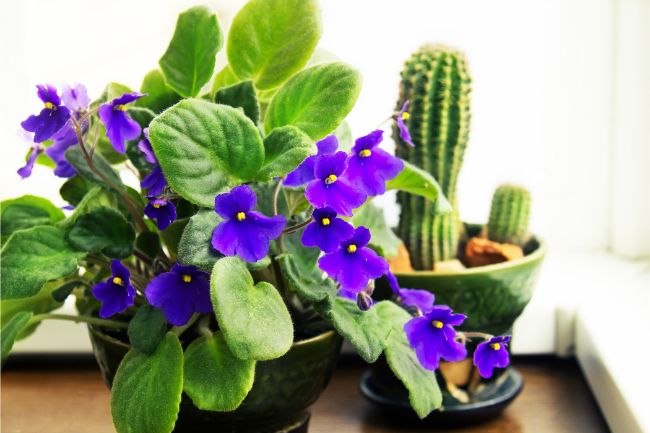
Such a popular and beautiful choice, this small houseplant will really stand out when put on display in your home.
The only downside to growing African Violets is their rather demanding care requirements, which can put many people off enjoying this little gem.
Watering is the aspect of care where most people struggle. African violets needs continually moist but not soggy soil, so keep an eye on your plant daily and water once the soil is showing any hint of dryness.
African Violets are sensitive to the type of water used, so make sure to use room temperature water that has been filtered or been left to stand for 24 to 48 hours.
Only water African violets from the bottom, as water what gets on the foliage will cause unsightly foliar spotting, which will ruin the appearance of your plant.
High humidity requirements and precise lighting nneds add to the challenge of keeping African Violets healthy. Not one to pick as a first indoor plant, but for those looking to increase the difficulty, few small houseplants are quite as rewarding.
29. Paddle Plant (Kalanchoe thyrsiflora)
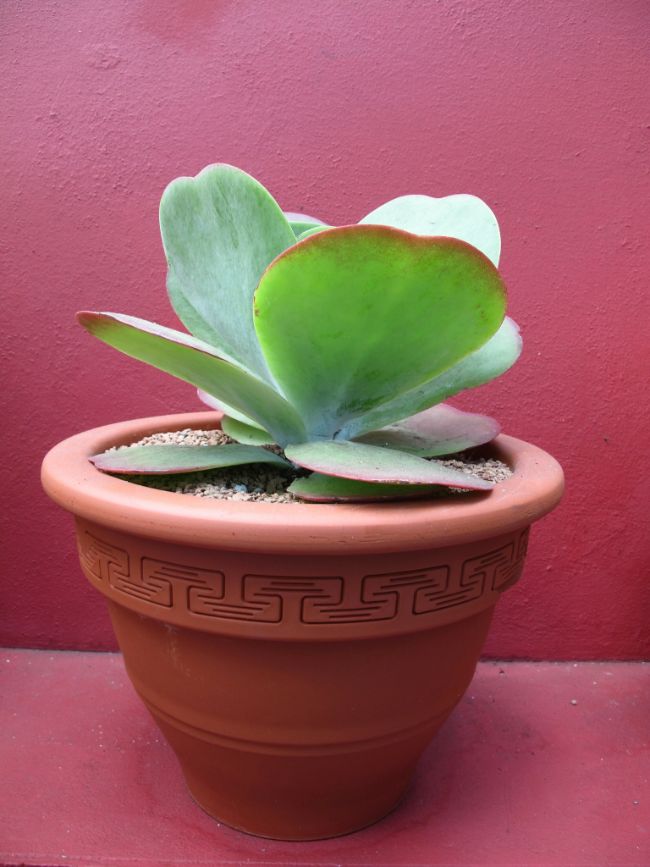
This rosette shaped succulent forms large paddle shaped leaves and is often known as the flapjack plant. It is a delightful small houseplant to grow and as long as you keep it relatively dry and grow in fast draining succulent soil and you wont go wrong.
As with all succulents, grow it in a pot that isn’t too large as this will help the potting mix dry faster and avoid the most common problem, which is root rot. Full sun or bright indirect light is best for this plant and will prevent it from stretching.
30. Lavender (Lavandula)
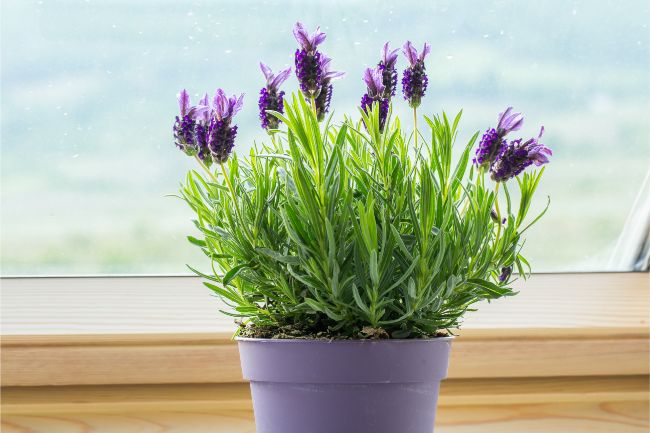
Lavender not only looks wonderful, but smells divine, so if you want a small indoor plant that can provide you with a fragrant home, then Lavender is a great choice.
It requires bright light to thrive indoors, so a south facing window is best. Rotate the pot every week or so to ensure even plant growth and water thoroughly once the top half of the soil is dry. The plant will show signs of distress if overwatered or underwatered, so monitor the dampness of the soil every few days.
31. String Of Hearts Plant (Ceropegia woodii)
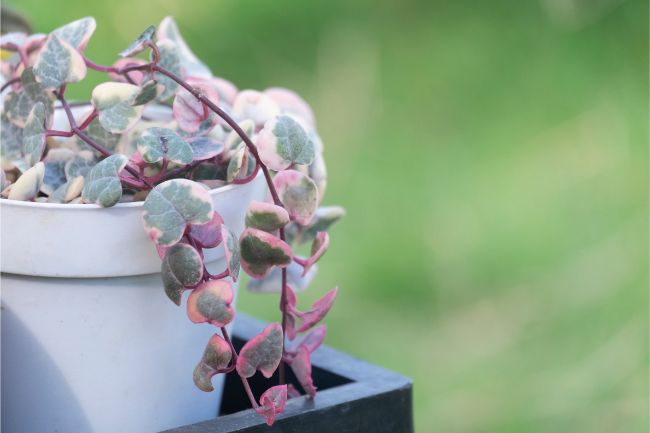
String Of Hearts Plant, or Rosary Vine, as it is often called is a lovely small houseplant that will vine and hang from its pot, providing a fascinating display.
Heart-shaped leaves grow in pairs every few inches along the vines. The delicate patterned surface of the leaves and light pink underside only adds to the beauty of this unique houseplant.
The individual vines can grow to several feet in length, providing plenty of options to display this lovely plant in your home. String of heart plants like plenty of light and sparse watering, but is fairly resistant to a bit of neglect.
32. Button Fern (Pellaea rotundifolia)
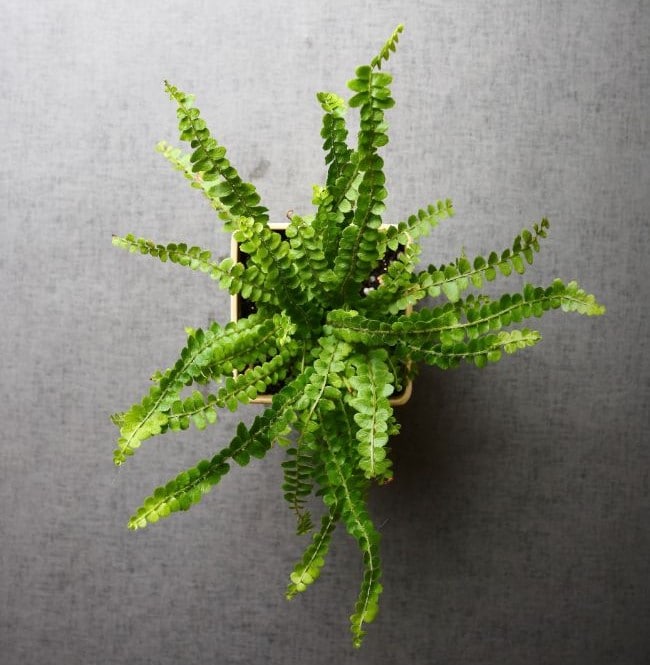
There’s something so satisfying about the dark green button-shaped leaves that neatly attach to the delicate stems of the Button Fern.
Smaller than many other fern houseplants, this makes it a good choice for a bright bathroom window. Higher humidity is important for Button Ferns to thrive and very well draining soil to avoid root rot
33. Baby Tears Plant (Soleirolia Soleirolii)
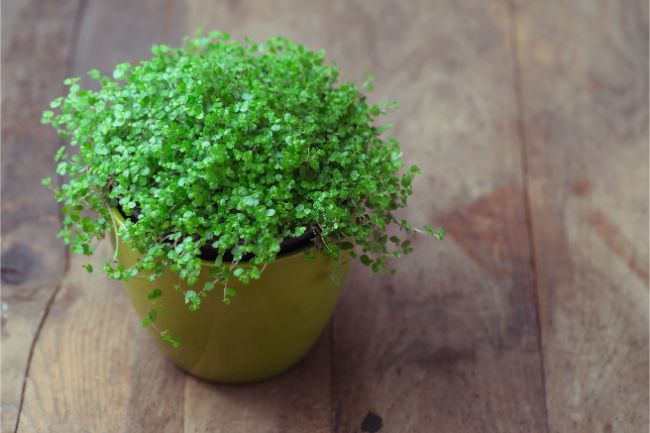
This fluffy carpet of teeny tiny leaves is just a joy to grow. Impossibly cute in a tiny pot, it loves to spill over the sides creating a lovely hanging effect as it grows.
Baby tears plants look like they should be hard to care for, but this small indoor plant is really very easy to grow and very versatile. It will tolerate fairly low light conditions, making it suitable for darker corners of your house.
Higher humidity requirements are important, which is why I love to group it in a terrarium with nerve plants and polka dot plants, where it looks fantastic.
34. Aluminum Plant (Pilea cadierei)
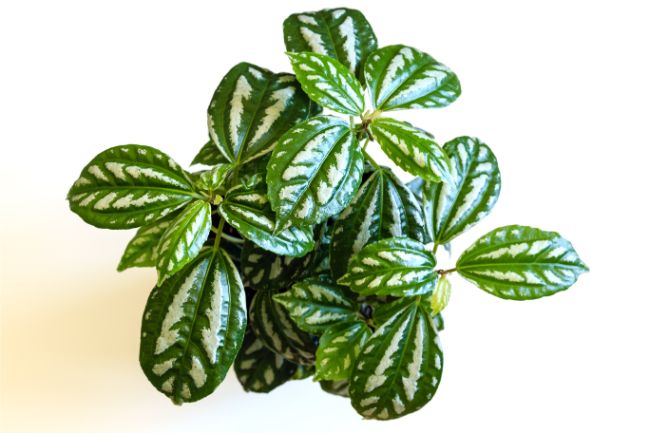
The name of this small indoor plant comes from the metallic colored detailing on the vibrant green oval leaves. It gives the plant a high contrast appearance which looks really well.
As long as you meet the basics of providing bright, indirect light and watering once the top inch or so of soil is dry, then Aluminum plants are easy to care for.
35. Desert Rose (Adenium)
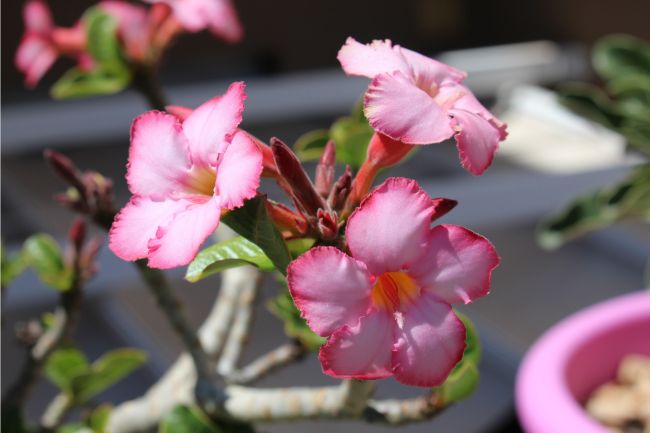
This spectacular flowering succulent produces a great display of flowers in red, pink, yellow or white as long as you can provide the high light requirements that it needs. Unlike many of the other flowering houseplants on this list, Desert Roses are easy to grow, provided they are given plenty of light and warmth.
Being a succulent plant, they are adapted to infrequent watering, so will tolerate some neglect.
The spectacular blooms of the desert rose are a pure delight in an indoor space, and the swollen trunk, known as a caudex is almost as interesting, but in a very different way.
A desert rose is sure to be a plant that people will comment on when they visit your home, and being so easy to care for, there are few reasons not to pick one up.
36. Cape Primrose (Streptocarpus)
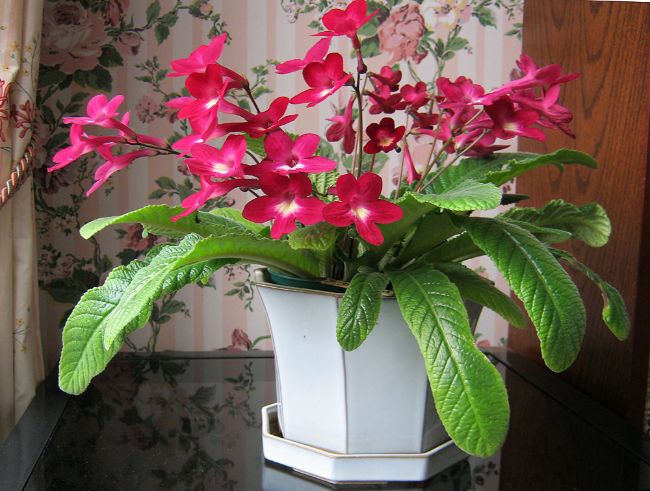
The cape primrose is the perfect option for people who want the benefits of an African violet, but want a slightly easier time looking after it. More tolerant of it’s growing conditions, with equally beautiful blooms, the Cape Primrose is a wonderful small houseplant.
Regular watering and bright sunlight will help you get the best from your Streptocarpus plant. Prune dead flower stalks at their bases to promote further blooming and you can enjoy flowers from spring to autumn.
37. Crown Of Thorns (Euphorbia milii)
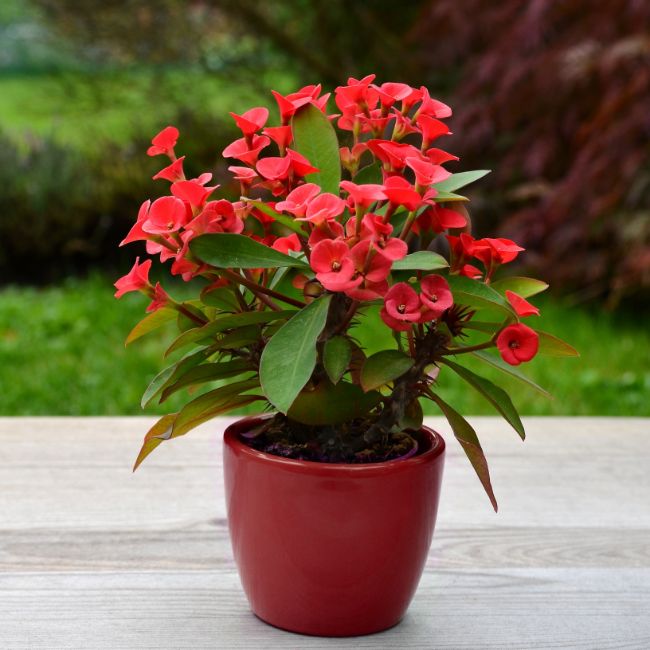
This compact, bushy succulent plant produces wonderful displays of color in the form of bracts, which surround the tiny flowers. Red, pink yellow and white varieties are available. It can be grown as a small indoor plant, but outside, it can grow to over 5ft tall.
It thrives without much attention to its care, so is a suitable plant for beginners. Bright light is essential to promote blooming. As a member of the Euphorbia genus, this plant is quite toxic, and can cause irritation on contact and more serious symptoms if ingested. Worth bearing in mind if you have children or pets at home.
Last Word
Many thanks for reading this article about my favorite small indoor plants. Hopefully, this has provided some inspiration for you to get a few plants to brighten your home. If you’re still struggling to decide what indoor plant is best for you, have a look at some of the following articles. Happy growing.

